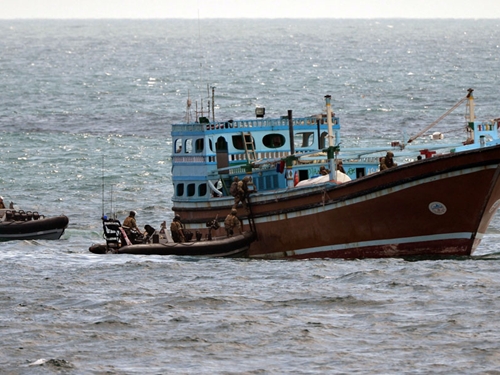Navys counter-piracy experts have reinforced their warning to seafarers
The Navy’s counter-piracy experts have reinforced their warning to seafarers to beware the scourge of modern-day buccaneers in the Indian Ocean. With the monsoon season drawing to a close, attacks by ‘pirate action groups’ trying to hijack merchant shipping off the Horn of Africa are expected to increase.
With a Merlin overhead and a two sea boats in the water, the boarding team of HMS Sutherland prepare to inspect a dhow in the Indian Ocean.
This is the business end of the Royal Navy’s efforts to curb the scourge of modern-day piracy and wider maritime crime in the region – and it’s about to get busier.
With the south-west monsoon season now ending, pirate activity is expected to increase – and smaller vessels are particularly at risk.
To that end, a small, specialist Royal Navy team based in Dubai has reinforce efforts to warn mariners of the dangers posed by 21st Century buccaneers.
The UK Maritime Trade Operations (UKMTO), based in Dubai, comprises nine Royal Navy personnel plus one merchant navy, advises merchant shipping of the principal threats, which stretches of ocean to avoid, and liaises between civilian shipping and the international force of warship patrolling ‘Pirate Alley’ (between Somalia and Yemen) and the wider Indian Ocean.

The concerted effort by the navies of the world to clamp down on the pirate menace – NATO, the EU and the 27-nation Combined Maritime Forces are all committed to the effort – as well as precautions taken by merchantmen (three out of four British or UK-flagged passing through the region now carry armed security teams) have seen the number of attacks drastically fall.
Last year 131 attempts were made to seize ships – but the pirates only succeeded in 23 instances.
So far in 2012, there have been 54 hijack attempts. Only six boats have been taken over, with five still in the hands of pirates.
In all, five merchant ships and seven fishing vessels/dhows with some 200 crew as hostages are currently being held for ransom.
To ensure more do not fall victim, the UKMTO sends out a flood of information to shipping in the region, its staff brief merchant ships in harbours such as Jebel Ali – the largest port in the Middle East – and holds regular conferences for merchant shipping leaders and mariners, like one just held Dubai’s International Seafarers Centre.
“During the meeting we covered a lot of ground and it was heart-warming to see how far this united approach to piracy has come,” said the UKMTO’s Lt Cdr Sue Roll.
“It was excellent to interact so effectively with the maritime stakeholders in the region.”
As for the Fighting Clan, she’s splitting her time between counter-piracy and counter-terrorism patrols as she enters the final two months of her deployment.
In the case of the dhow boarding depicted in these images, it was a ‘reassurance visit’ – to inform lawful seafarers of why the Royal Navy and Royal Marines are here and to understand the ‘pattern of life’ among the heavy shipping traffic in the region.
Whether it’s a friendly visit, or a full-on pirate incident, the procedure for Sutherland is the same: up with her 829 Naval Air Squadron Merlin – callsign Warlock – with its commando snipers in the back, and a green (RM) and blue (RN) boarding team on the water in the ship’s Pacific 24 sea boats to physically carry out the act of boarding.
It’s tense, it’s relentless, and it’s very demanding physically.
“Having experienced temperatures of up to 48˚C I never thought I’d miss Cornish rain so much,” said Flight Commander Lt Earl Kingston who’s normally based at Culdrose.
“The crew and engineers have done an outstanding job keeping us airborne.”
Proof of the international effort was provided when Sutherland joined forces with Canadian frigate HMCS Regina, also committed to the impressive maritime security mission.
Six members of the Fighting Clan, er, clan traded places with their counterparts aboard the Regina to see how a navy which was born out of the Senior Service 102 years ago does things.
Source: Royal Navy
































































